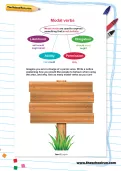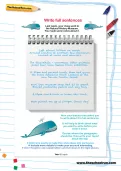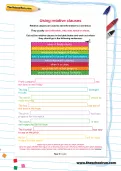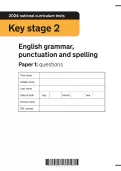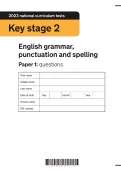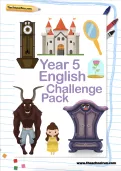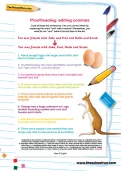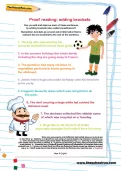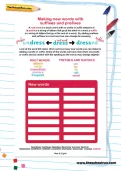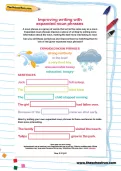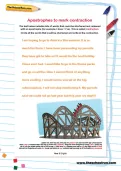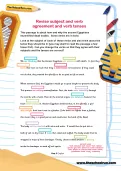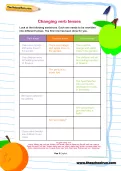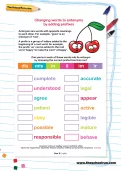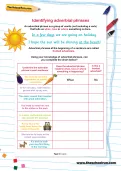Help your child prepare for the Year 6 English SATs, taken at the end of Key Stage 2, with some revision and at-home practice. These KS2 SATs past papers from 2024 are the official past papers from the Department for Education, used in schools.
or
Register to add to your saved resources
Help your child prepare for the Year 6 English SATs, taken at the end of Key Stage 2, with some revision and at-home practice. These KS2 SATs past papers from 2023 are the official past papers from the Department for Education, used in schools.
or
Register to add to your saved resources
Challenging reading comprehensions and activities for Year 5 readers and writers, designed to stretch your child and offer them the opportunity to explore their year-group topics in greater depth.
or
Register to add to your saved resources
Already a subscriber? to view this content.
Look at these list sentences. Can you correct them by replacing the word “and” with commas? Remember, you need to use “and” before the last item in the list.
or
Register to add to your saved resources
Already a subscriber? to view this content.
Can you edit and improve each of these sentences by adding brackets (also called parentheses)?
or
Register to add to your saved resources
Already a subscriber? to view this content.
Look at the word list. Work out how many new words you can make by adding a prefix or suffix. Some of the words can have more than one prefix or suffix and be careful with the spelling as the words may change slightly!
or
Register to add to your saved resources
Already a subscriber? to view this content.
A noun phrase is a group of words that act in the same way as a noun. Expanded noun phrases improve a piece of writing by adding more information about the noun, making the text more interesting to read. Can you edit these sentences and improve them by matching them to one of the given expanded noun phrases?
or
Register to add to your saved resources
Already a subscriber? to view this content.
This text includes lots of words that could be shortened and replaced with an apostrophe (for example, I have = I’ve). This is called contraction. Circle all the words that could be shortened and write in the contraction.
or
Register to add to your saved resources
Can you add the pronouns below into the gaps in this passage from The Tale of Squirrel Nutkin by Beatrix Potter?
or
Register to add to your saved resources
Already a subscriber? to view this content.
This passage is about how and why the ancient Egyptians mummified dead bodies. Some verbs are in bold. Look at the subject of each of these verbs and also think about the tense they should be in (you may want to read the passage a few times first). Can you change the verbs so that they agree with their subjects and the tenses are correct?
or
Register to add to your saved resources
Already a subscriber? to view this content.
Look at the following sentences. Each one needs to be rewritten into different tenses. Are you ready?
or
Register to add to your saved resources
Already a subscriber? to view this content.
A subordinate clause contains a subject and a verb, but it needs to be attached to a main clause because it cannot make sense on its own. Clauses can be linked by conjunctions, prepositions and adverbs. Adverbs are used to show sequence (eventually, finally, meanwhile), contrast (however, on the other hand) or cause and effect (therefore, subsequently). Which of the red adverbs from inside the brackets above would fit into the sentences below?
or
Register to add to your saved resources
Already a subscriber? to view this content.
Synonyms are words that have similar meaning. For example: ‘overjoyed’ is a synonym for ‘happy’. Cut out the following words. Can you match up the pairs of synonyms?
or
Register to add to your saved resources
Already a subscriber? to view this content.
Antonyms are words with opposite meanings to each other. For example, ‘good’ is an antonym of ‘bad’. A prefix is a group of letters added to the beginning of a root word; for example,
the prefix ‘un’ can be added to the root word ‘happy’ to make the word ‘unhappy’. Can you turn each of these words into its antonym by choosing the correct prefix from this row?
or
Register to add to your saved resources
Already a subscriber? to view this content.
Ellipsis literally means to leave something out. Ellipsis (or suspension points) are a form of punctuation represented by three dots. In a story, we might use ellipsis if someone starts a sentence but
doesn’t finish it. It is also often used to build suspense at the end of a paragraph or chapter. Where and why has ellipsis been used in this extract from a story?
or
Register to add to your saved resources
Already a subscriber? to view this content.
Sometimes we use hyphens to join a prefix and a root word, especially if the prefix ends with a vowel and the root word starts with a vowel. Cut out these prefixes, hyphens and root words. See if you can assemble them to make words.
or
Register to add to your saved resources
Already a subscriber? to view this content.
In writing, an ellipsis (...) shows that something has been left out or that someone has started a sentence but hasn’t finished it. It can also be used to build suspense at the end of a paragraph or chapter. Where and why has ellipsis been used in this story extract?
or
Register to add to your saved resources
Already a subscriber? to view this content.
Dashes can be used to indicate parenthesis (brackets can be used for the same purpose). Where do you think the dashes should go in these sentences?
or
Register to add to your saved resources
Already a subscriber? to view this content.
An adverbial phrase is a group of words (but no verb) that tells us when, how or where something is done. Using your knowledge of adverbial phrases, can you complete this chart?
or
Register to add to your saved resources
Already a subscriber? to view this content.
Sometimes dashes are used to indicate a pause in sentences that contain two independent clauses. Look at these sentences and add in the dash where you think it should go in each one.
or
Register to add to your saved resources
Already a subscriber? to view this content.
